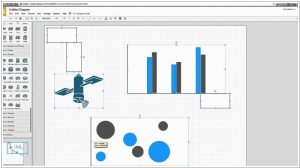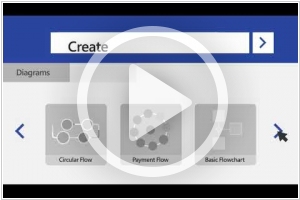Diagrams.net vs Microsoft Visio
July 25, 2023 | Author: Adam Levine
20
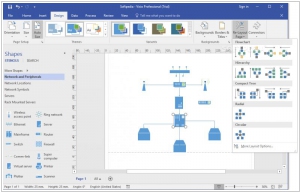
Create professional diagrams to simplify complex information with updated shapes, collaboration tools and data-linked diagrams. Simplify complex information with professional diagrams you can create in just a few clicks. Visio makes diagramming simple - whether you want to quickly capture a flowchart that you brainstormed on a whiteboard, map an IT network, build an organizational chart, document a business process, or draw a floor plan.
Diagrams.net and Microsoft Visio are both powerful diagramming tools, each offering unique features to cater to different user preferences. Diagrams.net, formerly known as Draw.io, is an open-source platform that excels in providing a free and collaborative diagramming experience with a vast array of templates and integrations. It is ideal for users who prioritize cost-effectiveness and flexibility in their diagramming projects, while still having access to a rich set of features. On the other hand, Microsoft Visio is a proprietary software that integrates seamlessly with the Microsoft Office suite, providing a comprehensive set of tools for creating professional diagrams and flowcharts. It offers advanced features, custom shape libraries, and integration with other Microsoft products, making it an attractive choice for enterprise users seeking a comprehensive and standardized diagramming solution.
See also: Top 10 Diagramming software
See also: Top 10 Diagramming software
Diagrams.net vs Microsoft Visio in our news:
2020. Draw.io's open source diagramming is moving to diagrams.net
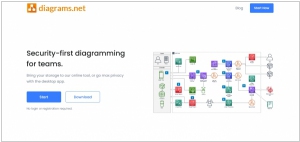
The widely used open-source diagramming web application, Draw.io, is undergoing a domain name transition, shifting away from its well-known .io domain to Diagrams.net. This change is motivated by the need to enhance security and uphold ethical practices. The decision to migrate stems from a security issue associated with .io top-level domains, compounded by a lack of communication from the domain administrator in addressing the matter. The absence of communication has eroded the trust of the diagrams.net development team in the .io TLD administrator. The transition process from Draw.io to diagrams.net will be gradual and extend throughout the entire year of 2020. During this transition period, the Draw.io domain will continue to host the diagramming web application without any redirections until the migration is fully completed.
2018. Microsoft Visio integrates with Hololense

Microsoft is positioning its AR headset, HoloLens, as a tool to enhance productivity, improve quality, and ensure safety by enabling companies to reimagine their processes, data, and workforce, ultimately driving business impact and customer value. One area of focus for Microsoft is updating its Visio software, which now includes features tailored to intelligent manufacturing scenarios, such as facility layout optimization. To demonstrate the potential of intelligent manufacturing, Microsoft will collaborate with its customer, Dürr AG, and incorporate the expertise of Visio partners, including FaciWare GmbH for facility management solutions and X-Visual Technologies GmbH for PnID (Piping and Instrumentation Diagram) solutions.
2018. draw.io allows to automatically create diagrams from CSV files

Various departments and professionals within companies often deal with data presented in tables or spreadsheets, and converting that data into diagrams can enhance comprehension. Importing data into draw.io for visual representation is now a straightforward process. In this format, each row corresponds to a shape, while the columns contain the respective data for those shapes. It is important to note that not all columns are used as data within the diagram; some serve as instructions for shape formatting or act as identifiers for drawing connectors between shapes. Additionally, draw.io allows you to customize the formatting of the shapes according to your preferences.
2017. draw.io is now available as a Trello Power-Up
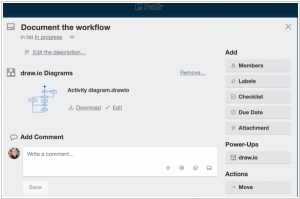
Now, keeping related draw.io diagrams alongside Trello tasks has become significantly easier. Instead of relying on shared folders, cloud file services, or cumbersome email exchanges, you can now embed one or multiple diagrams directly into any Trello card. This seamless integration allows for more efficient collaboration with your team. With draw.io, you have the flexibility to create various types of diagrams, including flowcharts, BPMN diagrams, mockups, wireframes, UML and ER diagrams, floor plans, electrical circuits, infographics, and more. The platform offers an extensive shape library, robust tools for importing diagrams in different formats, and securely stores all data within Trello.
2017. Microsoft launches Visio Online editor
Microsoft Visio held the distinction of being the initial favored tool for constructing schemes, diagrams, and designing software and site interfaces. However, the emergence of numerous online alternatives such as Gliffy and OmniGiraffe, offering collaborative features, caused many users to shift their attention away from the resource-intensive Visio. Interestingly, while Microsoft released online versions of popular Office editors like Word and Excel, they initially did not provide an online version of Visio. Only in 2016 did the company introduce Visio Online Viewer, which allowed users to view Visio files online. Recently, Visio Online has transformed into a comprehensive application that permits diagram creation and editing directly in the browser, facilitating team collaboration. This full-featured version is priced at $5 per user per month, while the free Visio Online Viewer is included in nearly all Office 365 plans.
2017. Visio Online adds new themes, shapes and guides
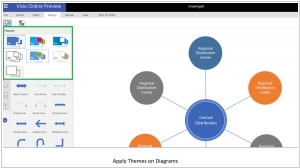
Microsoft has introduced an update to its Visio Online service, enabling users to effortlessly create, edit, and share diagrams directly from their web browser. The addition of Quick Shapes greatly enhances the diagram creation process. By hovering over the arrows adjacent to any shape, users can access the quick shapes panel, allowing them to select the desired shape that will automatically connect to their existing one. Furthermore, smart guides facilitate shape alignment, while the flexibility to customize connector types based on specific requirements has been implemented. In addition to expanding the shape library, Microsoft has incorporated a search-box above the shape panel, enabling users to easily locate their desired shapes. Beyond the capability to include personal images, users now have the option to utilize the "Find and Add a picture from web" feature to incorporate external images from the internet.
2017. Microsoft Injects Power BI Insights Into Visio Diagrams
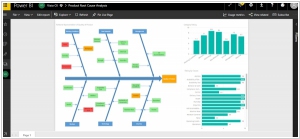
Microsoft Power BI users now have the capability to integrate their business analytics with floorplans, business processes, and other diagrams created in Visio. Currently available in preview, this new feature allows users to leverage diagrams created in Visio as a foundation to overlay valuable business insights. By combining Visio and Power BI, users can present and analyze data both as diagrams and traditional Power BI visuals in a unified platform, facilitating operational and business intelligence for a holistic understanding. It is possible to establish a connection with a Visio diagram hosted on SharePoint or OneDrive for Business. The underlying Power BI data is then automatically and intelligently linked to the diagram based on its shape properties, eliminating the need for manual linking.
2017. Microsoft releases public version of Visio Online for Office 365 commercial users
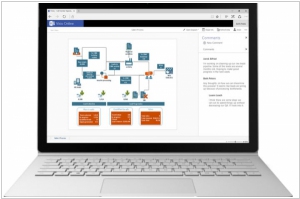
Microsoft has unveiled a cloud-based edition of Visio, granting paid Office 365 users access to this popular software for the first time. Initially, a preview version of Visio Online was released exclusively to a limited group of Office 365 users in November, and Microsoft has since incorporated their valuable feedback into the current version. Similar to its predecessor, the public release of Visio Online is free and primarily designed to enable users of the full Visio for Windows application to seamlessly view and collaborate on Visio diagrams across various platforms via a web browser. As Visio Online functions solely as a viewer, it is necessary to create your Visio diagrams using the complete version and subsequently share them through OneDrive for Business or SharePoint Online. Once the diagrams are available online, you can utilize the Visio Online version to conveniently share them with others.
2017. Visio allows to convert process map data in Excel into Visio diagrams
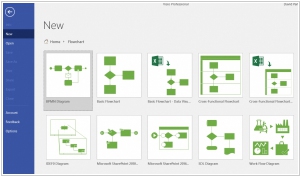
Microsoft has introduced a new feature called Data Visualizer in Visio, enabling the automatic conversion of process map data from Excel into data-driven Visio diagrams. This functionality empowers business analysts to transform process steps and associated metadata, organized in a structured Excel table, into visually appealing Visio diagrams. Users have the flexibility to utilize either a pre-designed Excel template or their own customized spreadsheet. The Data Visualizer feature includes a basic template as well as a template specifically designed for cross-functional flowcharts. The latter provides a sample mapping table that can be populated with diagram metadata. The mapping table consists of predefined columns such as process step number, description, dependencies, owner, function, phase, and more. Additionally, users have the freedom to personalize the table by adding their own custom columns, ensuring that it aligns with their specific business requirements. With Data Visualizer, Microsoft aims to streamline the process of creating data-driven Visio diagrams, empowering analysts to efficiently visualize and communicate complex information.
2017. Microsoft Improves Database Diagramming in Visio Pro
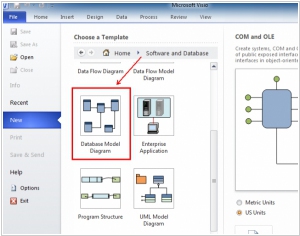
Microsoft is leveraging its diagramming application, Visio Pro, to provide insights into intricate database deployments and business processes. Recently, the company introduced a database reverse engineering tool that enables users to delve into the structure of their databases and comprehend the interconnectedness of various elements. This tool is part of the Database Modeling add-in and offers support for several popular databases, including MySQL, Oracle, and Microsoft's SQL Server. Through an intuitive wizard, users can select the source database and specify elements to be included in the visual representation, granting them complete control over the resulting diagram. Notably, the database diagram automatically updates whenever there are changes in the source information, ensuring that everyone has access to the most up-to-date data.

